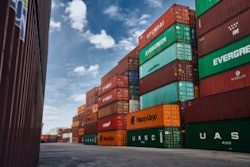
Supply chain innovations have led to improved efficiency, reliability and profitability. But they’ve also created new risks for supply chain companies.
Supply chain visibility is the use of data and technology to track orders from manufacturer to delivery to help prevent order and shipment errors.
Automated warehouse technology such as warehouse execution and control systems, labor forecasting, resource planning and scheduling, returns management systems, real-time capabilities, simulation and modeling, mobile apps and APIs, machine learning and artificial intelligence, cloud-based computing, telematics, mobile robots, wearables and more are all in place to provide guidance and enable companies to actually see – and prepare – for what’s to come.
And, what’s to come could be anything from a supply chain disruption to a minor bottleneck. It could mean hunkering down to weather a storm or re-routing fleet due to road construction.
So, when the Biden-Harris Administration launched Freight Logistics Optimization Works (FLOW), it set forth a path for which supply chain visibility and information sharing becomes vital – if not necessary -- components in keeping the flow of goods moving through the supply chain.
"A key aspect of FLOW is addressing supply chain visibility, which requires upstream trusted information that informs decisions further downstream. The ability to leverage information and physical triggers in the same way accelerates supply chains by cutting out unnecessary steps and manual tasks while increasing the routing efficiency and accuracy which will lower transit times and especially costs," says Michael Kaufmann, global market development director – logistics, Avery Dennison Identification Solutions.
According to a White House press release, FLOW includes 18 initial participants that represent diverse perspectives across the supply chain, including private businesses, warehousing and logistics companies, ports and more. This initial phase aims to produce a proof-of-concept freight information exchange by the end of the summer.
“We expect this new information-sharing initiative will provide companies with the visibility they need to improve the accuracy of sales and order forecasts, lower inventory levels, reduce supply chain costs and uncertainty and more effectively mitigate supply chain risks. At the same time, it will allow businesses to achieve closer relationships with the supply chain partners,” says Jeff Trino, VP, supply chain for Genpact. “Unfortunately, we’ve never had supply chain industry standards around collaborative information sharing amongst trading partners in the logistics space. Today just about every client we work with is struggling with the same general issue—gaining visibility of products at any point in the supply chain. This lack of visibility is normally a symptom of larger issues such as the inability to share timely data, the lack of talent to meet the changing supply chain environment and an inability to consume and analyze large amounts of data. In the next 6-12 months, we expect the current inflation crisis will continue which will have an effect on the supply chain, specifically when it comes to logistics. This inflationary climate places further emphasis on the need for programs like FLOW.”
However, the ongoing Russia/Ukraine conflict continues to wreak havoc on already fractured supply chains, posing additional threats and challenges to an already fractured global supply chain. As a result, some industry experts question the success of FLOW during a time when it may be a little too late.
"FLOW is a great step in ensuring that key stakeholders have access to real-time information about the supply chain status. However, one major challenge will be the data each participant shares will be delivered in various formats over different platforms. The use of AI will need to be used strategically to transform documents and streamline process bottlenecks in order for FLOW to make an impact, otherwise, it’ll become another bureaucratic program. Take customs declarations, for example. Planes can be delayed, and packages can miss shipments if stakeholders are not on top of processing the customs declarations, which originate many times as documents. Are they scanned in the cab, captured via a mobile app, or scanned at the depot? All are valid options, but the key is speed and accuracy. How fast can you transform the text locked within a document into accurate and actionable process ready data is the key. FLOW is a needed and ambitious initiative, but participants will need to be on the same technology pace," says Bruce Orcutt, SVP at ABBYY.
Other challenges stem from a crippled supply chain that impacts ports, fleet, air cargo and more.
“As the ongoing crisis in Ukraine continues, we’re seeing companies pause shipments that are moving from China to Russia, which is impacting other modes of transportation and cost. The disruption will have ripple effects across many industries, which is already being felt in countless other parts of the world,” says Ron Greene, VP of business development for Overhaul.
While supply chain management has always been a challenge for global supply chains, FLOW will provide that insight needed to mend upended supply chains.
“With FLOW, participating organizations across the supply chain, including private businesses, trucking, warehousing and logistics companies and ports will help guide oversight of the flow of goods and create a digital infrastructure to speed up operations. While this is a needed step from a federal perspective, it also signals the work that businesses throughout the supply chain have already done to digitally transform the supply chain, including real-time tracking and truck routing within an ERP system to help move along goods and avoid hiccups. The global movement of goods may become more complex as e-commerce activity connects consumers to global regions, which means that distributors and logistics companies need to prepare now with the right digital tools to avoid disruption,” says Pete Zimmerman, North American software sales manager, VAI.
Regardless of how quickly companies employ supply chain visibility technology or where in the supply chain they focus most on, hopefully FLOW will instill the forecasting needed to stay ahead of what’s yet to come.


















